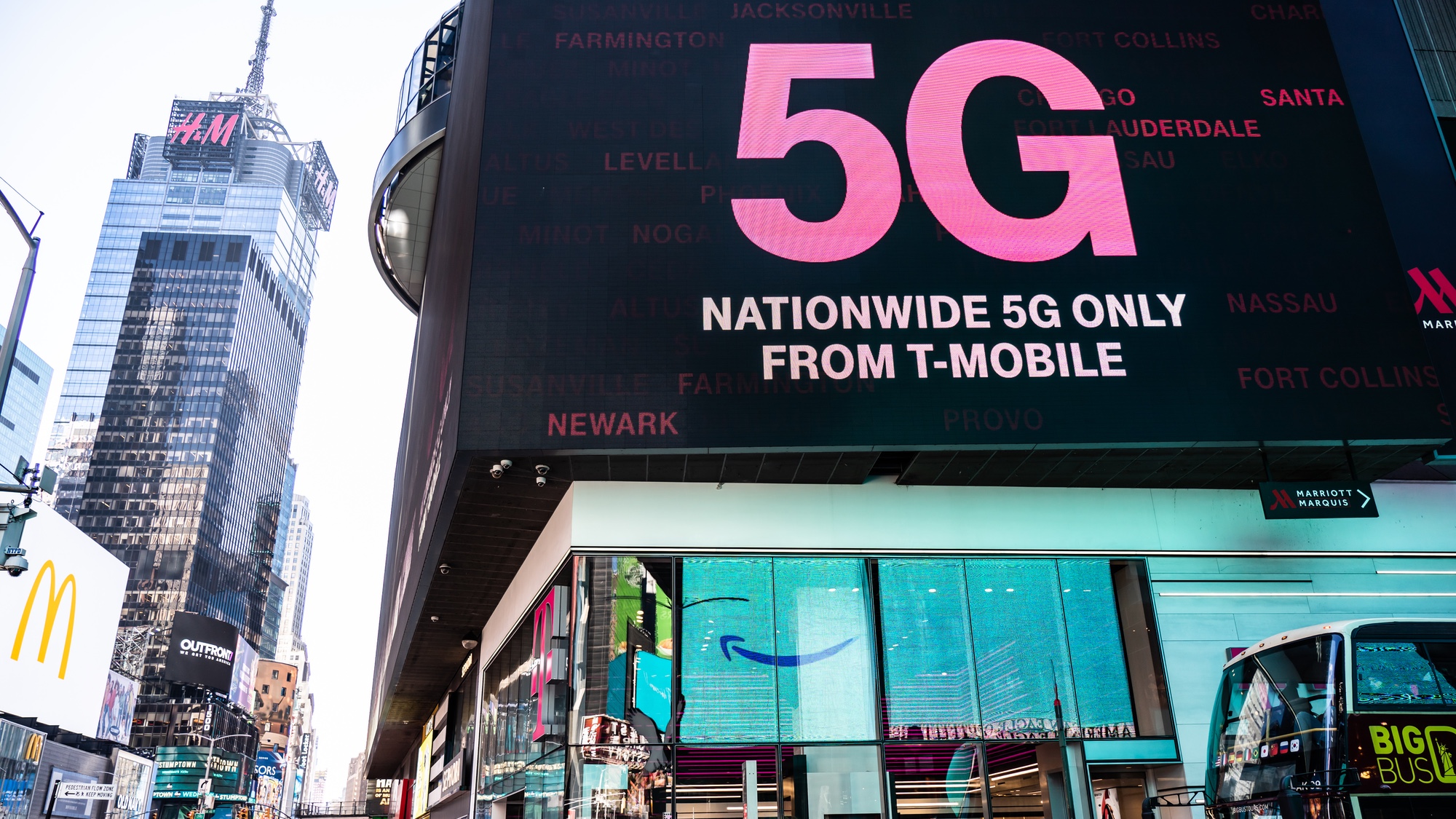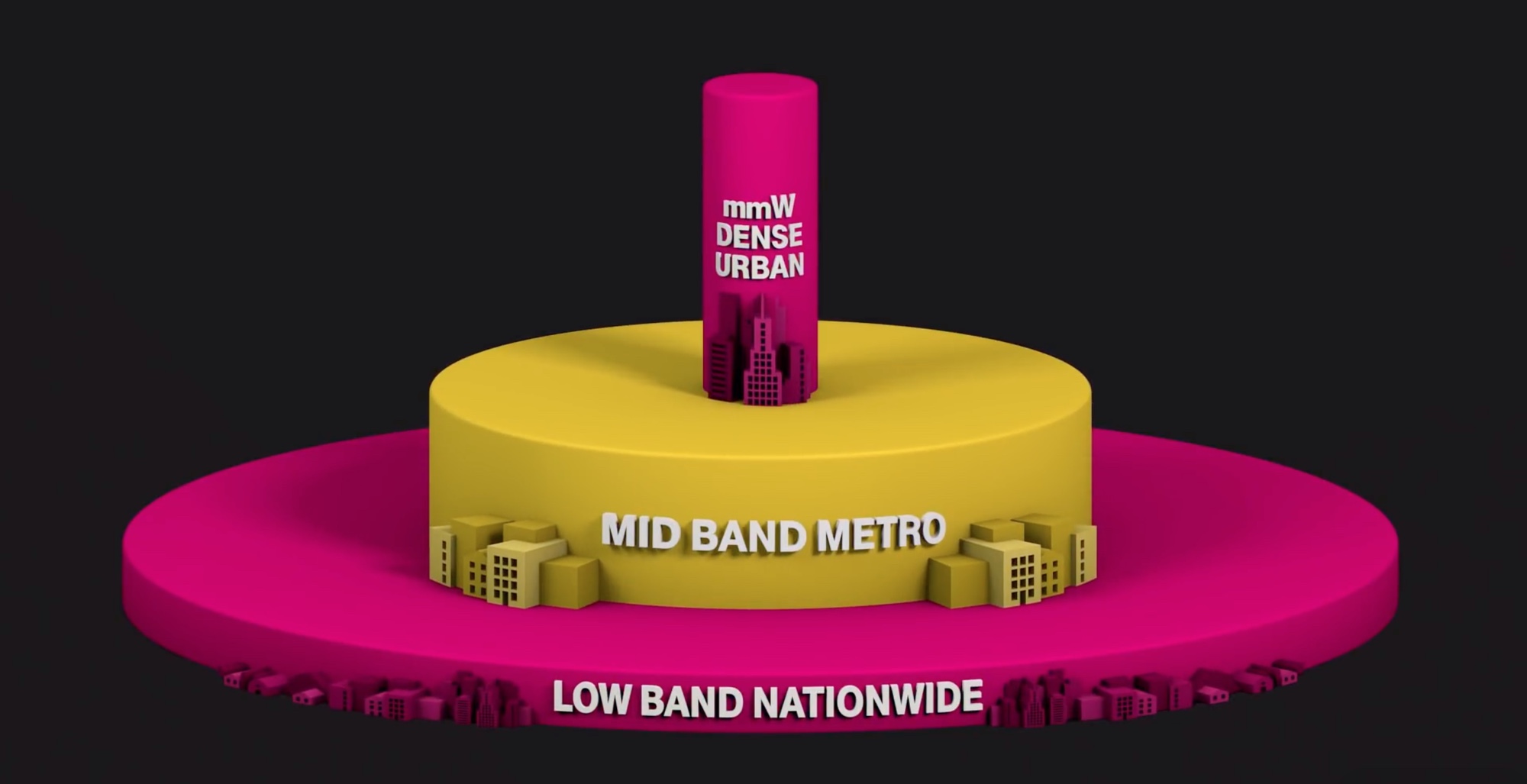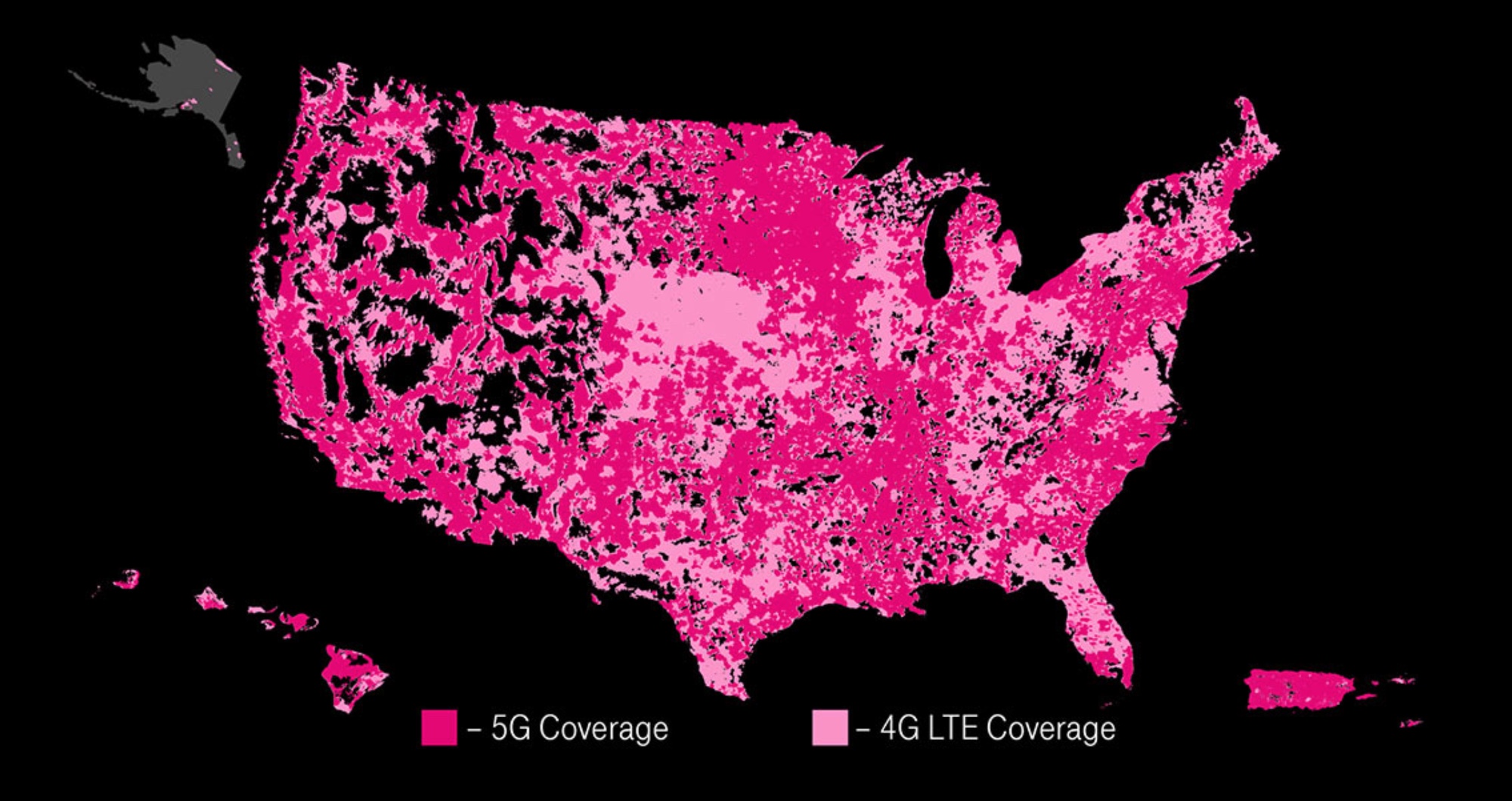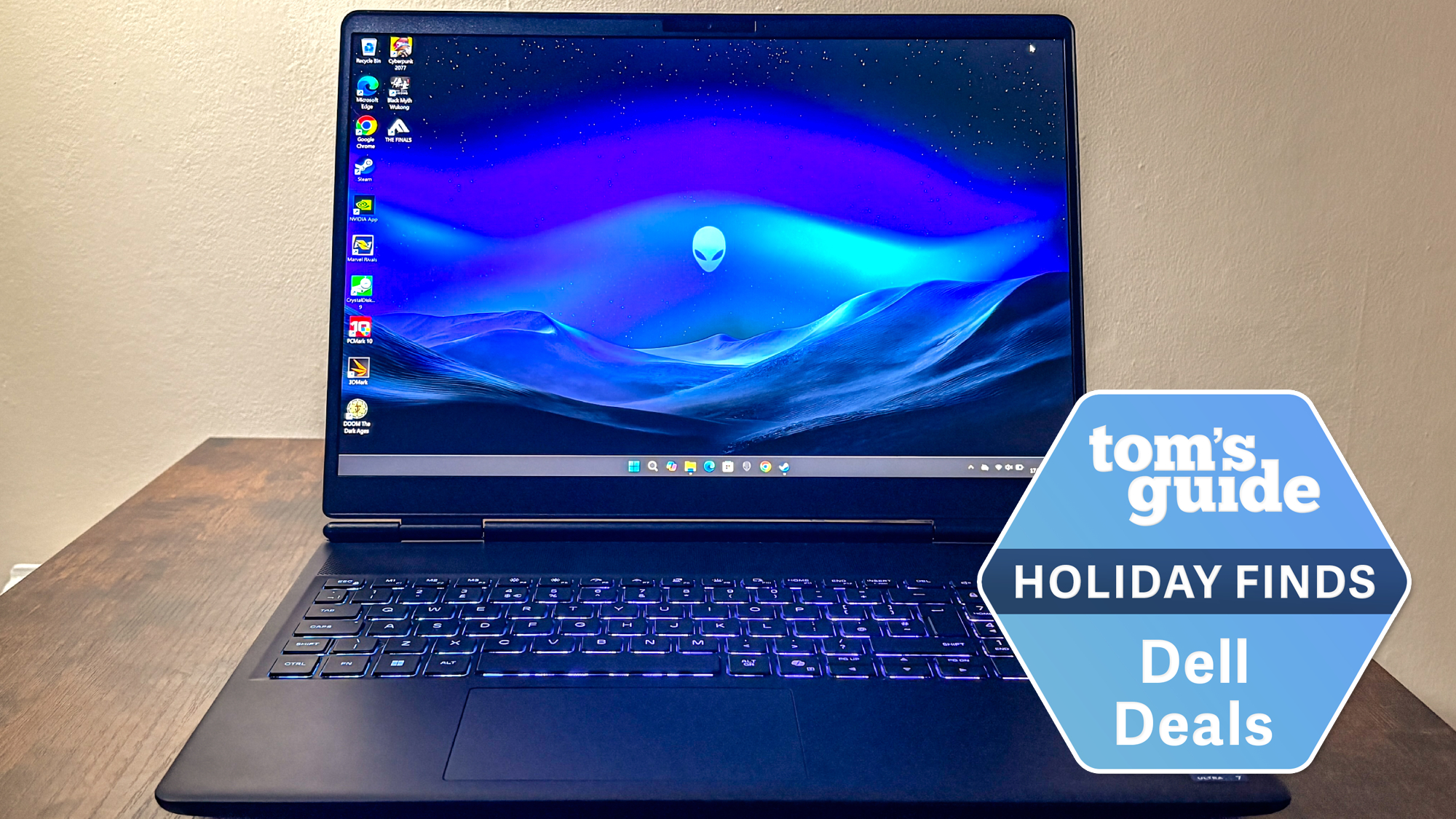T-Mobile 5G map, phones, plans, speed and home internet
The T-Mobile 5G network reaches from coast to coast — here’s what you need to know

Update: T-Mobile just became the first carrier to offer this iPhone plan.
T-Mobile 5G came a little after its rivals launched their own networks, but it's here and it's nationwide.
If you need to find a 5G network with which to use one of the best 5G phones, then take a look at what T-Mobile offers. Its "layer cake" of different 5G standards may sound odd, but we're here to help explain what it is, where you can get T-Mo 5G and how fast it can be.
T-Mobile’s 5G plans were well underway before the Sprint-T-Mobile merger became official during 2020, but adding Sprint’s 5G to its own network has certainly aided T-Mobile’s effort to enhance 5G performance, as it uses Sprint's mid-band spectrum to speed up its own 5G performance. That's helped T-Mobile boost its unlimited data plans, offering truly unlimited data with its most expensive plan while also offering 5G through one of the cheaper plans out there.
Here’s a closer look at what you can expect from T-Mobile 5G and what the carrier is planning going forward.
T-Mobile 5G bands: How they work
T-Mobile is using what it calls a “layer cake” approach to 5G, turning to different technologies to build out a far-reaching network with improved speeds and latency. Thus far, the focus has been on using sub-6GHz spectrum, which has an extensive reach, but only modestly faster speeds than LTE. This approach has formed the backbone of the nationwide 5G coverage T-Mobile launched in late 2019. (More on that below.) T-Mobile calls this coverage Extended Range 5G.
After its long-delayed merger with Sprint finally closed in 2020, T-Mobile began repurposing Sprint’s mid-band spectrum into its own network. That’s improving 5G performance in some of the cities that T-Mobile covers. "Together with Sprint, we're the only ones who can build 5G with breadth and depth," now-CEO Mike Sievert said at a November 2019 event detailing 5G initiatives under the new T-Mobile. This faster coverage is known as Ultra Capacity 5G.
Get instant access to breaking news, the hottest reviews, great deals and helpful tips.

T-Mobile also is eyeing millimeter wave (mmWave) technology to build out its 5G network, with some coverage in a handful of cities. That’s a stark contrast to rival Verizon, which made mmWave-based 5G the center of its initial 5G rollout efforts. As a result, Verizon’s 5G speeds were much faster during the last, but its initial network didn't reach as far as T-Mobile’s. (That's changed somewhat, after Verizon launched nationwide 5G coverage of its own in the fall of 2019.) As fast as mmWave is, it can’t penetrate obstacles like walls and windows — that means T-Mobile’s slower network can reach indoors while Verizon’s has a more difficult time.

It’s no surprise, then, that T-Mobile leads other carriers in 5G availability. As of April 2021, testing firm Opensignal says that T-Mobile's 5G availability has reached 33.1%. That's up from 22.5% in June 2020. More important, it's ahead of T-Mobile's rivals.
T-Mobile 5G coverage map
After flipping on some mmWave-based coverage in a half-dozen cities by mid-2019, T-Mobile turned its focus to using its sub-6 GHz spectrum to create a nationwide network. In December 2019, that network launched covering 5,000 cities and 200 million people.

T-Mobile’s 5G coverage has only expanded since then, thanks in no small part to to its Sprint acquisition. These days, T-Mobile says its 5G signal reaches more than 8,300 cities and towns, covering 287million people. That makes T-Mobile’s 5G network the largest, as Verizon says its nationwide coverage reaches 230 million people.
You can see if T-Mobile 5G extends to your part of the U.S. by checking out the carrier’s 5G coverage map.
Around a year ago, T-Mobile added Sprint's mid-band spectrum to its 5G service in Philadelphia and New York, broadening coverage depth while also boosting speed in those two cities. The New York expansion is particularly significant because that city was already served by T-Mobile's low-band and millimeter wave-based service. That means New York City is now served by all types of 5G through T-Mobile.
After those first two cities, T-Mobile added mid-band 5G coverage in Atlanta, Chicago, Dallas, Houston, Los Angeles and Washington D.C. By the end of September 2020, T-Mobile said this Ultra Capacity 5G coverage was live in 210 cities and towns, giving them a 7.5x improvement over LTE speeds on average. After the first three months of this year, T-Mobile said its Ultra Capacity 5G coverage reached 125 million people, with plans to go nationwide by the time 2021 draws to a close.
T-Mobile 5G speed
When T-Mobile turned on its nationwide network in 2019, we had a chance to test the service in Maui. At the time, the Uncarrier was promising a 20% boost on download speeds over its existing LTE coverage, which is roughly what we saw when testing T-Mobile 5G with a OnePlus 7T Pro 5G McLaren. In some instances, 5G was much faster than T-Mobile LTE, though in a few spots, performance was actually worse.
One encouraging test we ran at time involved downloading The Irishman off of Netflix. That three-hour-plus movie took 3 minutes to download over 5G; we stopped trying after 10 minutes over LTE. Just as important as the time was the fact that we ran this test indoors, something you really can’t do over faster mmWave-based 5G.

Because of the coronavirus pandemic, we haven’t had the opportunity to go out and see how T-Mobile expansion in New York and other cities has improved its 5G performance. However, Ookla went out and did some testing, reporting a 25% jump in mean download speeds for New York between January and mid-May 2020. As of the end of September 2020, T-Mobile said the addition of Sprint's midband spectrum had boosted its average 5G download speeds to 300 Mbps. These days, if you're living in a place where T-Mobile has incorporated Sprint's mid-band spectrum, your speeds can range between 300 Mbps and 1 Gbps, T-Mobile says.
For what it's worth, OpenSignal's April 2021 report says T-Mobile has the fastest 5G speed — the testing firm says T-Mobile has an average 5G download speed of 71.3 Mbps. While that may not seem as fast as what you'd expect from 5G, it's ahead of the averages for AT&T (54.9 Mbps) and Verizon (47.7 Mbps).
Ookla says T-Mobile is the fastest, too, having inched ahead of previous 5G speed champ AT&T. RootMetrics said T-Mobile ended 2020 with the largest 5G footprint of any carrier, but described the carrier's 5G speeds as "similar to its speeds on 4G LTE."
T-Mobile 5G phones
All the major flagship phones with 5G connectivity, be they from Apple, Samsung, OnePlus or others, are available through T-Mobile, so you shouldn't have to compromise on the phone you want.
Here's a round-up of T-Mobile's featured 5G handsets:
- Samsung Galaxy S22, Galaxy S22 Plus and Galaxy S22 Ultra
- iPhone 13, iPhone 13 mini, iPhone 13 Pro and iPhone 13 Pro Max
- Apple iPhone 12 mini, iPhone 12, iPhone 12 Pro and iPhone 12 Pro Max
- Samsung Galaxy S21 FE
- Google Pixel 6 and Pixel 6 Pro
- Samsung Galaxy Z Flip 3
- Samsung Galaxy Z Fold 3
- Revvl V+ 5G
- OnePlus 9 and OnePlus 9 Pro
- OnePlus Nord N200
- Motorola One 5G Ace
T-Mobile 5G network plans and costs
If you’ve got a compatible phone that’s capable of connecting to 5G, any one of T-Mobile’s current data plans will include 5G coverage at no additional cost. And T-Mobile's plans are now a lot more attractive if you've got a 5G device.
The carrier's new $85-a-month Magenta Max plan, which replaces the similarly priced Magenta Plus plan, and removes any cap on high-speed data. All unlimited data plans aren't actually unlimited — carriers have a cap on the amount of data you can use each month before they slow down your speeds. T-Mobile's Magenta Max eliminates that cap completely while offering additional perks like the ability to stream videos in 4K when using Netflix. Magenta Max users also enjoy 40GB of mobile hotspot data.
The $70 Magenta plan remains, and includes 5G coverage. T-Mobile has doubled the cap on that plan from 50GB a month to 100GB before you might see speeds slowed. Hotspot data has been bumped to 5GB on this plan.
Cheaper plans like the $60-a-month T-Mobile Essentials Plan and $15-a-month T-Mobile Connect plan can access 5G, too (though that latter plan is a tiered data offering).
T-Mobile is something of a trailblazer when it comes to not charging extra for 5G support and making it available to all plans. AT&T originally limited 5G coverage to its most expensive unlimited data plans before extending that service to its cheapest unlimited plan last August. Verizon continues to charge $10 a month for its Start Unlimited plan on top of that plan’s regular monthly rate if customers want to access 5G, though 5G coverage is included with Verizon’s three other unlimited plans.
T-Mobile 5G home internet
T-Mobile has made no secret of its interest in using 5G to deliver home internet service. During the Sprint merger hearings, the carrier vowed to deliver high-speed wireless broadband to 90% of the country by 2024, and 5G figures heavily into that effort.
And that home internet service is now live, capable of reaching 30 million homes. T-Mobile Home Internet costs $60 a month, and speeds top 100 Mbps using the carrier's existing wireless towers. Check your eligibility at T-Mobile's ISP website.
T-Mobile 5G hotspot
T-Mobile’s unlimited plans include hotspot data, but it’s either at LTE speed (5GB for the Magenta plan, 40GB for Magenta Max) or 3G. The carrier also sells a 5G mobile hotspot — the Inseego 5G MiFi M2000. That hotspot can support up to 30 devices, and T-Mobile's standalone hotspot plans start at $20 a month for 5GB of data.
You can see how the MiFi M2000 compares to other hotspot options at our best mobile hotspots page.
T-Mobile 5G network: What’s next
T-Mobile has big plans for the rest of 2021 — continue to build out its 5G network, leveraging Sprint’s spectrum and maintain its lead over other carriers. With the iPhone 12 out since last fall, we can also expect the Uncarrier to add more 5G-ready devices — something it's already done in 2021 with the arrival of multiple Galaxy S21 and OnePlus 9 models.
T-Mobile has done a good job bringing its 5G network to the most people in the last year. Its focus going forward will be to improve overall performance, as it looks to make the case that 5G is a leap forward over LTE.
- White House has unveiled cheaper internet for millions
- Verizon 5G: What you need to know
- How AT&T 5G compares
Philip Michaels is a Managing Editor at Tom's Guide. He's been covering personal technology since 1999 and was in the building when Steve Jobs showed off the iPhone for the first time. He's been evaluating smartphones since that first iPhone debuted in 2007, and he's been following phone carriers and smartphone plans since 2015. He has strong opinions about Apple, the Oakland Athletics, old movies and proper butchery techniques. Follow him at @PhilipMichaels.

